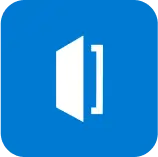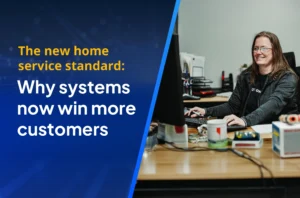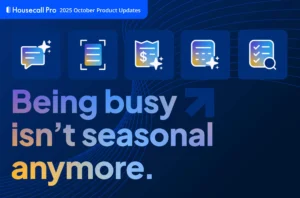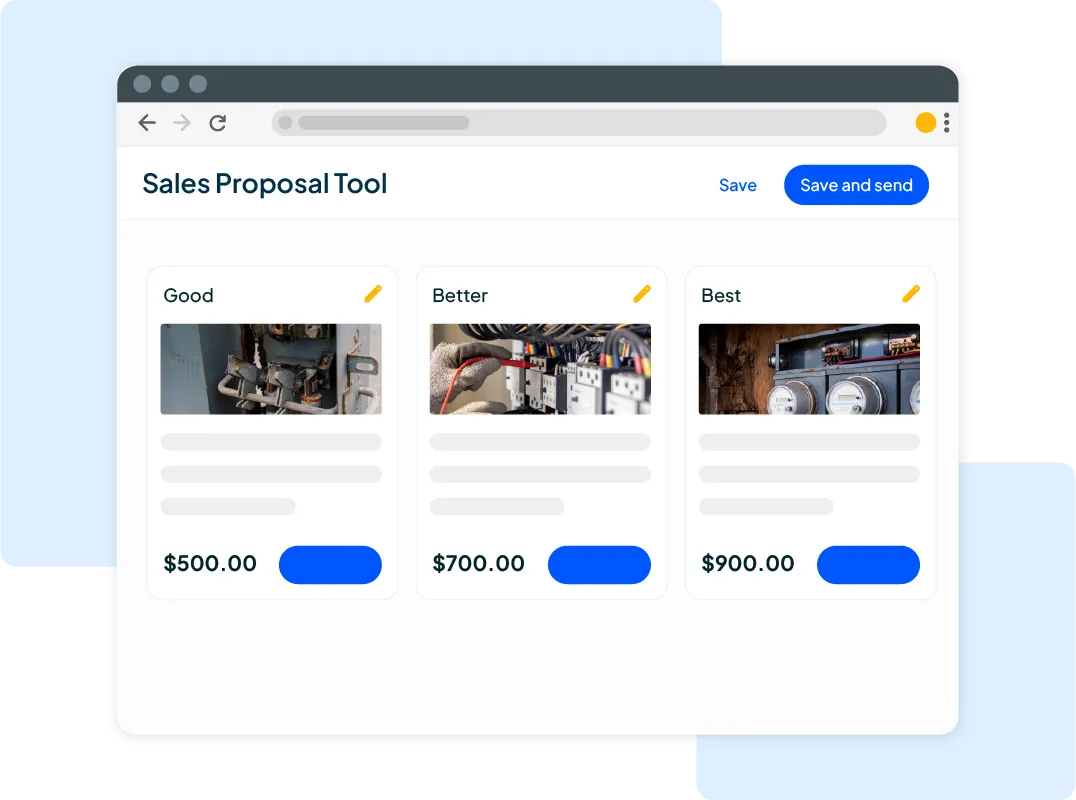Want to win more jobs with less effort?
Grow your business and send quick quotes with our home service software.

Want to see your potential revenue?
See what businesses like yours earn with Housecall Pro in 1 - 2 minutes.

You spend time building the perfect quote, hit send, and then…nothing.
No reply. No feedback. Just absolute silence.
But contrary to popular belief, it’s not always the price that turns a customer away. Often, the difference between landing a job and losing it comes down to one simple thing: the follow-up.
Following up the right way can keep your quote from getting lost and turn interest into booked jobs. Here, we’ll cover when to reach out, what to say, and how to follow up on a quote without sounding pushy—plus a few real-world templates you can start using right away.
- Why Following Up on Quotes Helps You Win More Jobs
- How Long to Follow Up After No Response?
- How Do You Politely Follow Up After No Response?
- How to Follow Up on a Quote Without Being Pushy
- Best Practices for Writing Effective Follow-Up Emails
- Improve Your Response Rates With These Quote Follow-Up Email Templates
- What If They Still Don’t Respond?
- Should You Follow Up on a Quote by Text?
- Using Software to Automate Quote Follow-Ups
- Following Up Helps With the Decision-Making Process
Why Following Up on Quotes Helps You Win More Jobs
Most customers won’t say “yes” the first time, even if they like your pricing and services. People get busy, lose track of emails, or delay decisions, often forgetting about the decision-making process altogether.
That’s where a well-timed follow-up comes in. It does three things:
- It puts you back at the top of their inbox
- It shows professionalism and persistence
- It opens the door for questions or revisions
Following up should be part of your customer management strategy, penciled in after you have written your quote. Done right, it builds trust, keeps conversations moving, and helps close more work.
How Long to Follow Up After No Response?
Timing your follow-ups is just as important as sending them. If you reach out too soon, you risk coming off pushy. Wait too long, and your quote could be forgotten.
Your follow-up schedule should look something like this:
- First follow-up: 24–48 hours after sending the quote
- Second follow-up: 4–5 days after your first message
- Final nudge: 1 week later, especially if your calendar is filling up
After that, it’s best to step back and let them be (but keep them in your CRM for future check-ins or seasonal offers).
This timeline strikes the right balance between persistence and professionalism. You’re giving the customer time to think while still showing that you’re proactive and organized. Following up too often can feel intrusive. Following up too late can make your business seem disinterested or unavailable.
How Do You Politely Follow Up After No Response?
It’s important to sound confident here, not desperate. The right tone can turn a cold lead into a booked job.
Keep things professional and positive by following these practices:
- Be friendly, brief, and helpful
- Avoid guilt-tripping or passive language like “just checking in…”
- Keep the focus on their needs, not your frustration
- Offer a clear next step (like scheduling, reviewing, or adjusting the quote)
For example, instead of saying, “Just wondering if you saw my email,” try: “Let me know if there’s anything you’d like to adjust or clarify. I’m happy to help!” It communicates the same thing, but with more clarity and confidence
How to Follow Up on a Quote Without Being Pushy
Winning more jobs isn’t just about being aggressive. It’s about being helpful and available. That starts with knowing when and how to reach out. The best follow-up strategies are consistent, clear, and focused on making things easier for the customer, not pressuring them to decide on the spot.
These best practices will help your messages sound clear, professional, and worth replying to.
1. Set Expectations When You Send the Quote
When you send your itemized quote, set the stage for what your customer can expect, like when they’ll hear from you and that you’re available for questions or changes.
This helps avoid surprise follow-ups and sets the tone for clear communication.
2. Follow Up Within 24–48 Hours
Most people look at quotes within a day or two. So, take advantage of that early interest and follow up quickly.
For example, you might say:
“Hi Becky, we wanted to see if you had a chance to review the quote we sent over. We’re happy to go over any questions or make changes if needed!”
3. Follow Up Again After 4–5 Days If No Response
If you’re getting nothing but crickets after a few days, give them a bit of space, but don’t let the lead go cold.
This time, offer to tweak the quote or mention your limited availability to create urgency.
Best Practices for Writing Effective Follow-Up Emails
Quote follow-up emails work best when they’re clear, concise, and centered on the customer. So, how do you write a follow-up that actually gets a response? Start with these tips:
- Start with a subject line that feels helpful, not salesy. Avoid using the words “follow up.” Instead, hint at the service you’re offering or the value you provide. Think: “Need help clearing your gutters this week?” or “Still thinking about your commercial cleaning quote?”
- Keep it short. Whether you’re writing a quote or estimate follow-up email, aim for 2 to 4 sentences. Respect your customers’ time while giving them a clear next step.
- Focus on their needs. Don’t ask why they haven’t replied. Instead, ask if they have questions or need changes to the quote.
- Be persistent, not pushy. Two or three follow-ups are plenty. After that, shift your energy to warmer leads.
- Always include contact details. A clickable quote link, your phone number, and a friendly email signature build trust and make it easy to respond.
These small tweaks can make a big difference in whether your follow-up gets a reply (or gets ignored).
Improve Your Response Rates With These Quote Follow-Up Email Templates
Initial Follow-Up Email for Quote (24–48 hours later)
Subject line: Need help finalizing your HVAC quote?
Message:
Hi Charlie,
Let me know if you’ve had the chance to review the HVAC repair quote I sent on [day]. I’m happy to walk through the details with you or make any changes you need to better fit your project. If you’d like to hop on a quick call or make changes, I’m here to help.
Thanks,
[Your Name]
Second Follow-Up Email for Quote (4–5 days later)
Subject line: Still considering that roof repair?
Message:
Hi Carol,
If your needs have changed or you’d like to adjust anything, I’m happy to revise your roof repair quote so it still works for you. Let me know if you’d like to move forward or need anything clarified.
Our schedule is starting to fill up for [month], so give me a heads-up if you’d like to lock in a spot.
Best,
[Your Name]
Final Follow-Up Email After No Response
Subject line: Still here if you need us!
Message:
Hi Ellis,
I’m checking in one last time to see if you’re still considering the plumbing quote we shared. If now’s not the right time, no problem! I’m here if you want to revisit the details or move forward down the line.
Take care,
[Your Name]
What If They Still Don’t Respond?
Even after three well-paced follow-ups, some leads will go radio silent. And, as disappointing as it is, this is normal. It doesn’t always mean “no.” Sometimes, it just means “not yet.”
Instead of writing them off, move the unresponsive could-be customers to a cold leads list in your customer management system. These contacts are still valuable. You can re-engage them later with seasonal reminders, service promotions, or limited-time offers.
You’ve already invested time quoting the job. Staying top of mind—without pushing—can turn a quiet lead into a booked job when the timing finally works out.
After all, you sent a final follow-up inviting them to reach out and revisit the quote when the timing is right for them. So, if they don’t respond, don’t worry—something might pan out later.
Should You Follow Up on a Quote by Text?
To email or to text? Texting a follow-up can be great and, in many cases, it might be your most effective option. Text messages tend to get opened faster than emails, making them ideal for time-sensitive follow-ups, reminders, or quick scheduling nudges.
They’re especially useful in home service industries, where your customers are routinely juggling things like work, errands, kids, or even services from other pros. A well-timed text keeps your quote top of mind without clogging their inbox.
Like the email follow-ups, your text doesn’t have to be long or flowery. Get to the point, let them know that you’re there to help, and be done.
For example:
“Hi Paris! Any questions about your [service type] quote? Let me know if you’d like to make changes or schedule. We’re happy to help!”
Before you send a quote follow-up by text, make sure you have permission to text the customer. Not only is this important for compliance, but it also sets expectations for communication and helps avoid confusion.
Using two-way SMS chat through Housecall Pro keeps all your messages organized in one place, so your team and your customers stay on the same page.
Don’t Forget the Power of a Follow-Up Call
If emails and texts aren’t getting a response, picking up the phone can go a long way. A quick follow-up call gives you a chance to reconnect on a human level, answer questions in real time, and end the conversation with a clear call to action, like scheduling the job or revising the quote.
Keep it short, polite, and helpful—no pressure, just a friendly check-in. Phone calls are especially useful for higher-ticket services or customers who prefer personal contact. Sometimes, hearing your voice is all it takes to close the deal.
Using Software to Automate Quote Follow-Ups
Following up manually on each and every quote takes time. And when you’re running a home service business, time is money. That’s why tools like Housecall Pro’s job quoting software & mobile app are so handy.
With automation, you can:
- Schedule personalized follow-up emails or texts as soon as the quote is sent
- Customize your message templates to reflect your brand’s tone and voice
- Track when a customer opens their quote so you can follow up at the right moment
- Convert approved quotes into scheduled jobs and invoices (instantly)
The best part? There’s no extra admin, no paper chasing, and no lost leads. Just clean handoffs from quote to job to payment, all in one place.
Get In Touch: 858-842-5746
Let us earn your trust
On average, Pros increase monthly revenue generated through Housecall Pro by more than 35% after their first year.
See plan options and feature breakdown on our pricing page.
Following Up Helps With the Decision-Making Process
There’s a good chance you won’t get an automatic “yes” when you send out a quote. And that’s okay. But if you’re not following up, you’re leaving work (and money) on the table.
Customers often need a nudge, a reminder, or a little more clarity before they feel ready to commit. And when you send that well-timed follow-up message, it can be the difference between a quote that ends up on a fast track to the digital trash bucket and one that gets accepted.
When you follow up consistently (and do it with the right tone and tools), whether you offer electrical work or seasonal HVAC services, you increase your chances of winning the job, earning repeat business, and building trust.
Housecall Pro helps you make follow-ups automatic, effortless, and on-brand, so you never miss an opportunity to turn a quote into real revenue. Give it a try today with a free 14-day trial.







